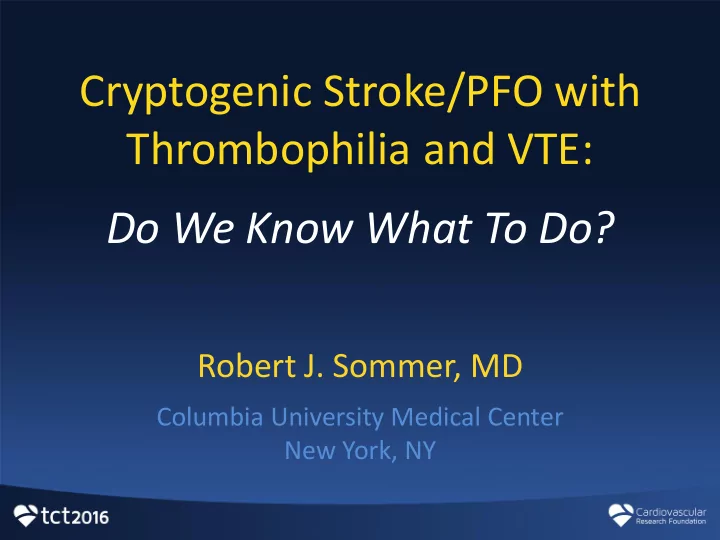

Cryptogenic Stroke/PFO with Thrombophilia and VTE: Do We Know What To Do? Robert J. Sommer, MD Columbia University Medical Center New York, NY
Disclosure Statement of Financial Interest Within the past 12 months, I, Robert Sommer, have had a financial interest/arrangement or affiliation with the organization(s) listed below. Affiliation/Financial Relationship Company • • Grant/Research Support W.L. Gore • • Consulting Fees W.L. Gore • • National PI – ASSURED Trial W.L. Gore
FDA Labeling for Amplatzer PFO 10/29/2016 “The Amplatzer PFO Occluder is indicated for percutaneous transcatheter closure of a patent foramen ovale (PFO) to reduce the risk of recurrent ischemic stroke in patients, predominantly between the ages of 18 – 60 years, who have a cryptogenic stroke due to a presumed paradoxical embolism, as determined by a neurologist and cardiologist following an evaluation to exclude known causes of ischemic stroke. ”
Cryptogenic Stroke Work-up • Acute onset neurologic symptoms with corresponding ischemic Infarct by cerebral imaging without other identifiable stroke source: – Cerebral vascular anomalies – Atrial Fibrillation – Carotid artery disease – Aortic atheroma – LAA thrombus – LV mural thrombus – L sided AV valve anomalies
Hypercoagulable Work-up • Inherited Thrombophilas: – Prothrombin Gene Mutation (G20210A) – Factor V Leiden Mutation (G1691A) – Protein S, Protein C, Anti-thrombin III deficiencies – MTHFR Mutations with elevated homocysteine levels – Others • Acquired Thrombophilias – Anti-phospholipid Syndrome – Generally require OAC
Do we know what to do when thrombophila (TP) is identified in a patient with CS/PFO without other known sources? • No. There is no RCT data to guide us. • What we do know …
Blood thinners reduce PFO/stroke risk • In all PFO RCT’s, OACs and antiplatelet therapy both reduce recurrent stroke risk, compared with historical controls - PICSS Trial. Homma et al. Circulation. 2002;105:2625-2631. - CLOSURE I Trial. Furlan et al. N Engl J Med 2012;366:991-9. - RESPECT Trial. Carrol et al. 5 Year data presented at TCT 2015. - PC Trial. Khattab et al. Trials. 2011;12:56-63. • By reducing the clot burden returning to the RA, lessening chance of paradoxical embolization
Inherited Thrombophilia • Inherited thrombophilias are associated with venous thrombus formation (not intra- arterial) and are known to increase the risk of VTE events - Rosendaal FR. The Lancet.1999;353:1167 – 1173. - Salomon et al. Arterioscler Thromb Vasc Biol. 1999;19:511-518. - Couturaud et al. Blood. 2014;124(13):2124-2130. • Increased RA clot burden will increase the risk of paradoxical embolization across a PFO
RESPECT 5 Year Follow-up Data • Recurrent cryptogenic stroke with PFO is more strongly associated with: - Atrial septal aneurysm - Large R to L flow by bubble contrast • Consistent with the accepted mechanism of paradoxical embolization through the PFO • In this high risk population, closure of the PFO was 75% better than on-going blood thinners Carroll et al. Presented at TCT, October 2015
Thrombophilia Conditions • Meta-analysis: 6 studies, 856 pts with CS/PFO, 1001 controls - In CS/PFO group, the PT (G20210A) more - prevalent {OR = 3.85 (CL 2.22 – 6.66)} FV (G1691A) less strong (OR = 1.28 (CL 1.03 – - 2.57) Carrying either PT or FV mutation increased CS - risk - OR 1.98 (CL 1.23 -2.83), OR 1.62 (CL 1.03 – 2.57) Thromb Haemost 2009;101:813-7.
Recurrent CVA +/- Thrombophilia Before PFO Closure Normal Thrombophilia Giardini et al. Am J Cardiol 2004;94:1012 – 101.
Recommendation • Thresholds should be lower for closing CS/PFO in patients with TP than in the general CS/PFO population, especially in those with higher risk PFO anatomy
What were they thinking??? Kernan et al. Stroke. 2014;45:2160-2236.
AHA/ASA Recommendations? Kernan et al. Stroke. 2014;45:2160-2236.
Oral Anticoagulation has never been shown to be superior to antiplatelet therapy in the CS/PFO population in preventing recurrent CS. • WARSS Trial (p = NS) • PICSS Trial (p = NS) • CLOSURE I Trial (p = NS) • PC Trial (p = NS) • RESPECT Trial (p = NS)
IVC Filter Multiple catheters passed through an IVC filter
Is it safe to implant a PFO device with a known thrombophilia?
Is PFO Closure Safe with TP? • Does TP increase the risk of device thrombosis? – Personal experience: • Over 4000 devices implanted over 20 yrs • All have had TP work-up, positive in ~ 15 - 20% • Five clinical cases of device thrombosis, none with documented TP
Is PFO Closure Safe with TP? • 72 consecutive patients with PFO and Stroke/TIA • 28% documented thrombophilia • No outcomes difference post closure at (20 +/- 11 mos) Am J Cardiol 2004;94:1012 – 101
Is PFO Closure Safe with TP? • 98 Consecutive Patients with PFO and Stroke/TIA • 31% had documented thrombophilia • No difference in device thrombosis or recurrent CVA events Minerva Cardioangiol 2009;57:285-9.
Recommendation • With standard post-implant anti-platelet therapy, there is no clear additional risk of device thrombosis in patients with TP
Conclusions (Editorial): • Cryptogenic stroke/PFO with: – Documented TP: should have a lower threshold for PFO closure than the non-TP CS/PFO population – Venous source: OAC X 6 months only, then long- term anti-platelet therapy, or closure with antiplatelet therapy, depending on presence/absence of high-risk PFO features. – No venous source: long-term antiplatelet Rx or closure with antiplatelet therapy depending on presence/absence of high-risk PFO features.
Recommend
More recommend